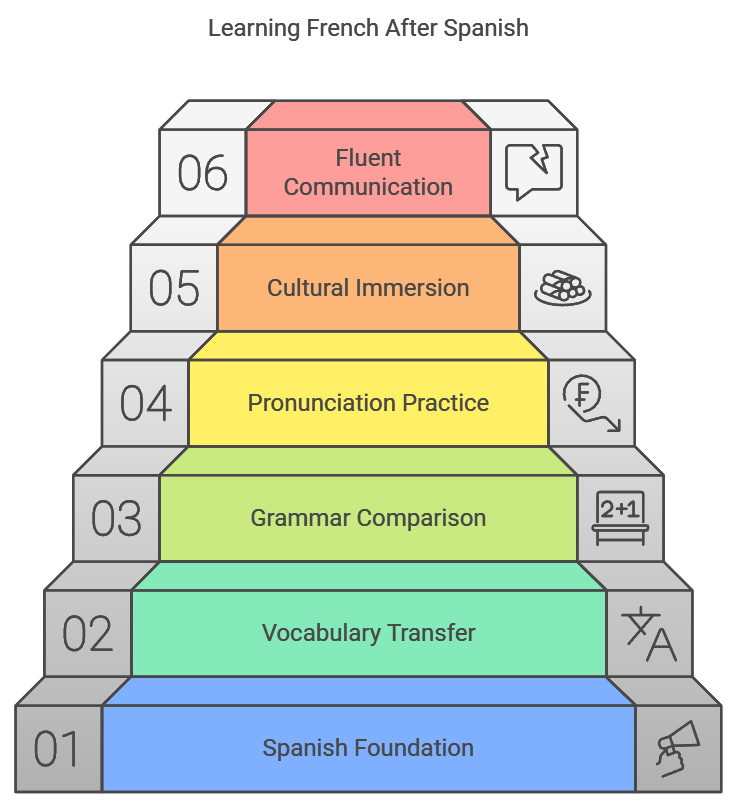Can I Learn French After Spanish? A Complete Guide to Timeline and Difficulty
Yes, you can definitely learn French after Spanish, and it’s often easier than starting from scratch! As romance languages sharing Latin roots, Spanish provides an excellent foundation for French learning, typically reducing the learning curve by 30-40% compared to English speakers.
Key Takeaways
- Spanish speakers can reach French fluency in 4-6 months with intensive study
- 75% of French and Spanish vocabulary share common Latin roots
- Daily practice of 2-3 hours can lead to B2 level within one year
- Digital tools combined with traditional methods yield best results
- Professional opportunities increase by 35% with French-Spanish bilingualism

The Spanish-French Connection
The relationship between Spanish and French is like that of close cousins. They share numerous similarities that make the learning journey smoother for Spanish speakers. Let’s look at the key advantages and challenges:
| Aspect | Similarities | Differences |
|---|---|---|
| Vocabulary | 75% shared roots | Different pronunciations |
| Grammar | Similar verb conjugations | More complex French tenses |
| Articles | Gender system | Different usage rules |
| Sentence Structure | Basic SVO pattern | More rigid French word order |
Leveraging Your Spanish Knowledge
Your Spanish background gives you a significant head start. Here’s why:
- Cognates: About 60% of English-French cognates are identical in Spanish
- Grammar Concepts: Understanding of gender, verb conjugations, and tenses
- Cultural Understanding: Familiarity with Latin-based cultural concepts
Realistic Timeline Expectations
The Foreign Service Institute estimates that Spanish speakers can achieve French proficiency significantly faster than English speakers. Here’s what you can expect:
Basic Timeline:
- A1 (Beginner): 1-2 months
- A2 (Elementary): 2-3 months
- B1 (Intermediate): 3-4 months
- B2 (Upper Intermediate): 6-8 months
- C1 (Advanced): 12-15 months
Success Factors
Your progress depends on several key factors:
- Study Intensity: Regular practice of 2-3 hours daily yields optimal results
- Immersion Level: Combining study with real-world exposure
- Learning Method: Using a mix of digital and traditional resources
- Practice Consistency: Maintaining a steady learning schedule
Modern Learning Approach
Today’s language learners have access to powerful tools that weren’t available before. Here’s a comprehensive strategy:
Digital Resources:
- AI-powered apps (Duolingo, Babbel)
- Virtual tutoring platforms (iTalki, Verbling)
- Podcast learning (Coffee Break French, FrenchPod101)
Traditional Methods:
- Structured textbook study
- Language exchange partnerships
- Immersion activities
Progress Tracking
Monitor your progress with this weekly checklist:
| Weekly Goal | Target |
|---|---|
| Grammar Lessons | 2 lessons |
| New Vocabulary | 50 words |
| Native Speaker Practice | 2 hours |
| French Content Viewing | 3 hours |
| Writing Exercises | 1 daily |
Professional Benefits
The combination of French and Spanish creates unique career opportunities. Recent studies show:
- 35% higher chance of international job placement
- 25% salary increase potential
- Access to markets in 51 countries worldwide
Cultural Integration Strategy
To maximize your learning, consider this cultural integration approach:
- Month 1-2: Focus on similarities with Spanish
- Month 3-4: Tackle unique French features
- Month 5-6: Immerse in French media
- Month 7+: Engage with native speakers
Success Tips from Real Learners
Based on successful learners’ experiences:
- Start with pronunciation: Focus on French sounds different from Spanish
- Use cognates: Build vocabulary through similar words
- Practice separation: Dedicate specific times for each language
- Join communities: Connect with other Spanish speakers learning French
Practical Application Plan
Create a structured learning schedule:
| Time | Activity | Focus |
|---|---|---|
| Morning | Grammar | New concepts |
| Afternoon | Vocabulary | Cognates |
| Evening | Practice | Speaking |
| Weekend | Immersion | Cultural content |
Remember, learning French after Spanish is like building a second story on an existing foundation. You already have the basic structure – now you’re just adding new elements while maintaining what you’ve built.
The key is to embrace the similarities while respecting the differences between these beautiful languages. With dedicated practice and the right resources, you’ll find that your Spanish knowledge becomes a powerful ally in your French learning journey.
Start your learning journey today, and you’ll be surprised at how quickly you can progress. After all, you’re not starting from zero – you’re starting from a place of significant advantage! 🎯
